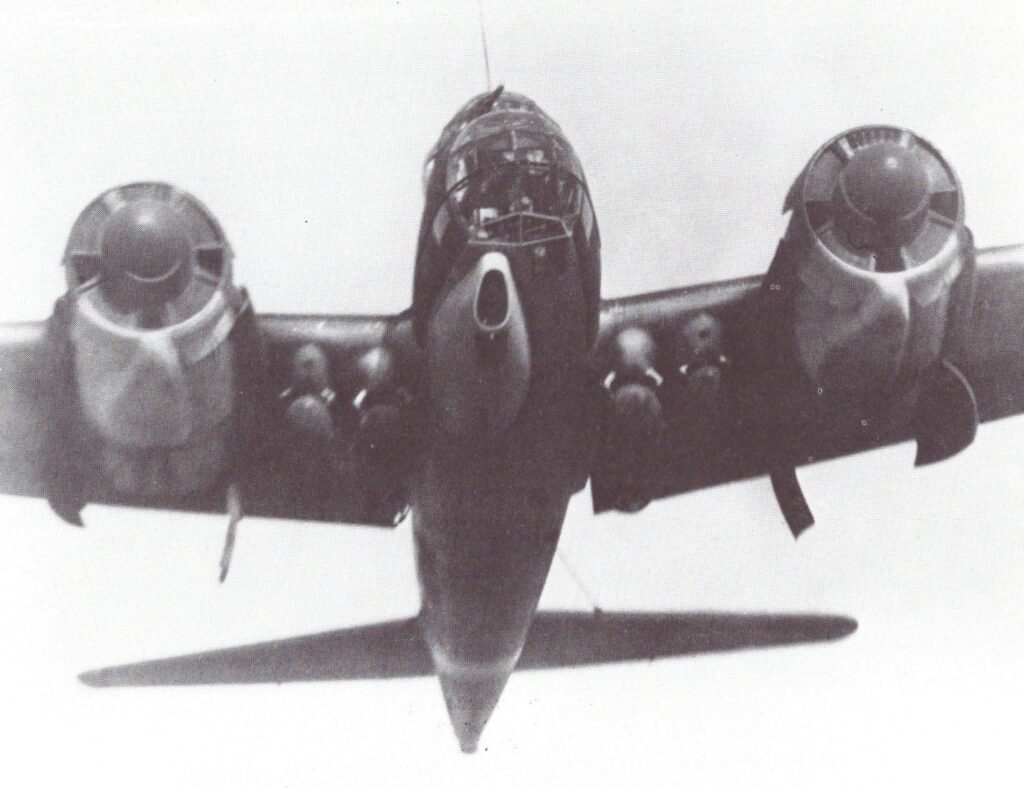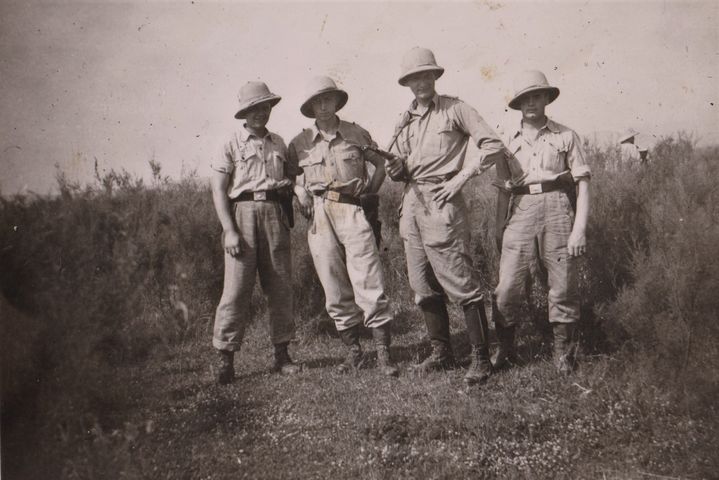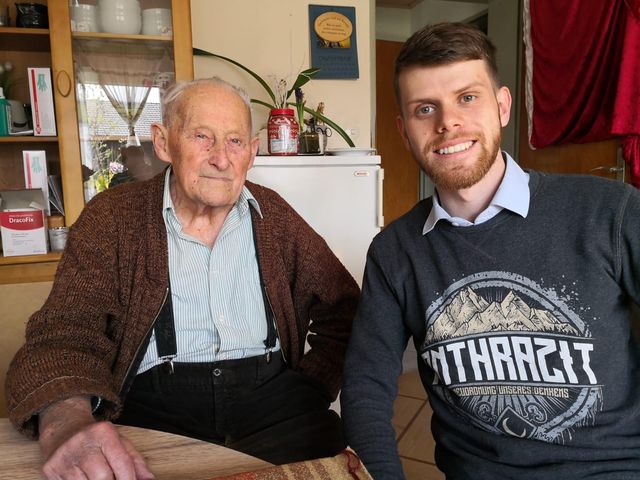In many long hours of interviews in the summer of 2021, I was able to document the military career of former radio operator Hans Schneider. Our conversations revolved in particular around his combat missions over the Mediterranean. Mr. Schneider had a good memory and could recall even the smallest details of individual events. He knew how to tell amusing anecdotes, but he never ignored the seriousness of what was happening at the time. Unfortunately, there was often a lack of chronology and in order to arrange his stories in a chronological order, we went through the entries of his squadron chronicle together.
Almost all of his squadron's missions were listed in this chronicle. Escort flights for convoys to Africa, the search for enemy submarines, attacks on English warships, but also the search flights for missing comrades. Within his unit, he feared the fate of crashing at sea, not being rescued and dying of thirst on the open sea. On special rescue flights they tried to find inflatable boats or life jackets of airmen who had landed in distress. It was often a search for the famous needle in the haystack.


In passing, Mr. Schneider mentioned in conversation that this fate had almost befallen him once. An incident that we had not yet documented for his book. We had discussed his shoot-down over Africa in 1942 and the way into English captivity several times and documented it in all details. But another crash? - had remained unmentioned until then. There are probably not many people who experience, or rather survive, an airplane crash on the open sea and later tell about it with such serenity. Mr. Schneider's stories are excerpted as a reading from the book.
"Once again we were to accompany a steamer as a backup and got ready for takeoff around noon. We climbed into our refueled aircraft and took off in a northerly direction out to sea. In a slow climb we climbed to a few hundred meters altitude. When we were already ten minutes away from the field, one of the engines began to sputter. There was a clatter and a crash and all at once the engine stopped and the propeller stopped with a jerk. We had a piston seizure! Since we were still climbing, we had barely picked up speed and the bomber was noticeably slowing down. We all realized what a predicament we were in. The pilot operated the emergency hoist for the bomb cargo. We made a hop upward as the bombs rushed down. The emergency hoist prevented the bombs from detonating and they fell into the sea without detonating. Meanwhile, the other engine continued to run without problems, but the airborne propeller of the broken engine continued to slow us down. The pilot pushed the nose of the engine down and began to fly a wide sweeping turn toward the coast. I sent several SOS distress calls out into the ether. Hopefully, there were other aircraft nearby that would relay our predicament to the ground control center. Let's not crash over the sea and then not be found. We descended again in the direction of Crete. The coast was already in sight, but we were losing more and more altitude. It soon became clear to us that we would not make it to land. The life jackets were strapped tighter and we got ready for an emergency ditching. The emergency release for the pulpit was activated. With a jerk, the Plexiglas pulpit flew away above my head. Everyone was ready to get out of the plane as soon as it hit the ground. We were only five or ten meters above the surface of the water when the pilot pulled the plane steeply upward with a jerk. This was important so that we would come up with the tail first. If we had dived in nose first, the heavy engines would have pulled us down immediately.
Everything worked as we had learned for this emergency. With a jerk and a sway, we touched down cleanly on the surface of the water. The plane glided along for a few more meters, then everything was silent. Only the gurgling sound of the water entering the fuselage was audible. I looked down and saw water already around my feet. The pilot asked if everyone was okay. We answered in the affirmative, only the gunner Pfannhuber had slight bruises on his ankle. We unstrapped ourselves and climbed out of the cockpit onto the wing. The fuselage was already half filled with water, but there was still air in the wings and the Ju was floating on the sea. We discussed what we should do. We didn't know if our SOS radio call had been heard. The plane would soon sink, and how would they find us at sea? The coast was in sight, although it is always difficult to estimate distances correctly at sea. Everyone wore a life jacket and we decided to swim to shore. From the wing I let myself slide into the water in full flying gear, which was not a nice feeling. Close together we swam off. From a safe distance, we could watch the end of our bomber. First the cockpit submerged. Because of the engines, the center of gravity was very far forward. Slowly, the whole plane began to rise more and more vertically. In the end, only the tail rose steeply out of the water, until finally there was nothing left to see, except for a layer of oil and some debris. The wreckage is still resting on the seabed today.
For us, the energy-sapping journey to the shore began, which in the end was further away than we first thought. It took us more than two hours to finally get our feet back on the ground. Disgruntled, we crawled out of the water and tried to wring out our flying clothes. It didn't take long before some Greeks came rushing over. They had probably observed our crash from land. We could not communicate, but these civilians greeted us very friendly. Together we went with them to their village. We were given something to eat and we could rest. They told us that they had informed other German soldiers about our whereabouts. We stayed overnight with these hospitable villagers and the next day a bucket truck came to pick us up. Our airman had to write a report on the incident and that was the end of the matter. However, the injuries of our gunner Pfannhuber turned out to be more serious than first thought and he had to be taken to a military hospital. After his recovery he was given some time home leave and a new gunner was assigned to our crew. Unfortunately, I cannot say what became of my comrade Pfannhuber. I never saw him again and nothing else could be found out about him. Hopefully he also survived the war!"
The fate of the plane had already interested me a lot at that time. Had it been salvaged? Mr. Schneider just shrugged his shoulders: "It's probably still there today. The Luftwaffe has certainly not fished it out...". „Liegt wahrscheinlich heute noch dort. Die Luftwaffe hat es sicher nicht mehr rausgefischt…“.
On my next visit, I brought a map and asked him to narrow down the crash site. However, this was only vaguely successful. Even the exact date could not be determined, only narrowed down to two weeks.
Through Facebook I managed to get in touch with some Greek history enthusiasts who were trying to document wrecks of planes and ships in Greek waters. They were very interested in the matter as they had no information on this accident so far. After questioning older Cretans, it turned out that Mr. Schneider's plane ditched near "Cape Stavros". Among the helpful Cretans who helped the crew ashore was an Orthodox priest named Nikolaos Andrea Stamatakis.
No information is available on the recovery of a Ju-88 in the Cape Stavros area. According to current nautical charts, a water depth of 150 meters can be assumed there. It is therefore very likely that Mr. Schneider's aircraft is still resting on the seabed today.
In recent years, Greek authorities and search teams have begun to search the sea areas around Crete for undiscovered wrecks. A search in the area of Cape Stavros is also being considered. I would have liked to tell Mr. Schneider about the discovery of his machine and to present him a sonar picture. Unfortunately Mr. Schneider died in the meantime at the proud age of 101 years.


The report will be updated as soon as there are new findings. Until then, we recommend our book "Im Sturzflug auf Alexandria" about the career of Hans Schneider. We hope to publish an English translation later this year.
Adrian Matthes, Erlangen, März 2023

The search for Hans Ju-88